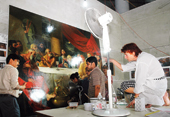| |
| Conservator Renate Kant (right) directs the Intach team putting the final touches to The Last Supper by Johann Zoffany at a makeshift laboratory in St John’s Church on Wednesday (Bishwarup Dutta); (below) the Metro report on February 15 |
| |
The solemn beauty of Johann Zoffany’s painting of The Last Supper, which hangs in St John’s Church and is the city’s most prized artistic possession, stands revealed once again and will be inaugurated on Saturday evening.
It has been restored over five months at the church next to Raj Bhavan by a team of conservators from the Indian National Trust for Art & Cultural Heritage (Intach) headed by Renate Kant, a German painting conservator based in Singapore.
The 10ft x 12ft painting by Zoffany (1733-1810) was done when he spent six years in India. He was born in Frankfurt but is considered one of the founding artists of the British School of the 18th century who introduced the “conversation piece”. His works hang in the Tate Gallery, Uffizi and the Louvre, besides the Victoria Memorial Hall.
Zoffany presented the painting to the church on April 9, 1787, and it once served as an altar piece. It incurred the wrath of the people on whom he had modelled the Apostles, who are significantly larger than Jesus himself. The flaxen haired St John sits next to Christ.
Judas with a tortured visage was said to have either been modelled on a “certain English resident at the Court of Lucknow” or Tulloh, a well-known Calcutta auctioneer. In 1888, a newspaper correspondent noted with dismay the “shameful treatment” meted out to it, and “the torn frayed canvas, and the large hole near the nose of Judas Iscariot”.
Kant said the “vandalised” painting was “hanging and sagging” and there were numerous gashes at the bottom. But now everything “is consolidated and structurally stabilised”.
She introduced her co-workers to a new method of retouching which was not so easy to pick. She used an Italian resinous paint named Maimeri which is applied with synthetic resin. One of the main procedures was to stabilise the delamination from the second previous relining of the canvas.
Kant conjectured that there were at least two major interventions, one in the 18th century itself after the vandalism, and perhaps a 100 years later. The picture had received a “very well constructed stretcher we could recycle”.
The original frame, too, has been retained. The gilt was cleaned and it was consolidated with injections of glue and ethanol. Kant returned every six weeks to oversee the work. Now this Last Supper will “never, ever need servicing again”, she maintained.
“I am very happy and appreciative that my teaching was so fruitful,” remarked Kant, who has spent 15 years working in Asia, on Thursday afternoon in the makeshift laboratory put up in the church, which is the same age as the painting. She added in jest that she often had to be the “dragon lady”. Perched on a sprawling table she directed the brushstrokes of Subash Chandra Baral, who led the Intach team of five, as he applied varnish on the canvas.
G.M. Kapur, state convener of Intach, says the project was proposed by the organisation, which provided the manpower and logistical support, for upgrading the skills of its conservators.
Reimar Volker, the director of Goethe Institut/Max Mueller Bhavan, Calcutta, says the institute provided around Rs 11 lakh for the project. “We would like to continue the project next year, possibly expanding into other fields of restoration (sculptures, textiles, and manuscripts). There are a few potential partners and collaborators both in Germany and here in Calcutta,” he added.
Renate Kant is, however, disappointed that the budget did not allow an acrylic UV buffered sheet to be put up in front of the painting to protect the surface from dirt.
“I do hope somebody is generous enough to support the project to prolong the lifespan of the painting. Glass cannot be used for security reasons. There is no problem with the lighting as the lux level is low inside the church and the painting has not faded.”
She stressed that although the German artist is highly rated, the painting has a Christian theme and “it belongs to local history owing to its dedication to St John’s Church. Its local value is higher than its international value.”












